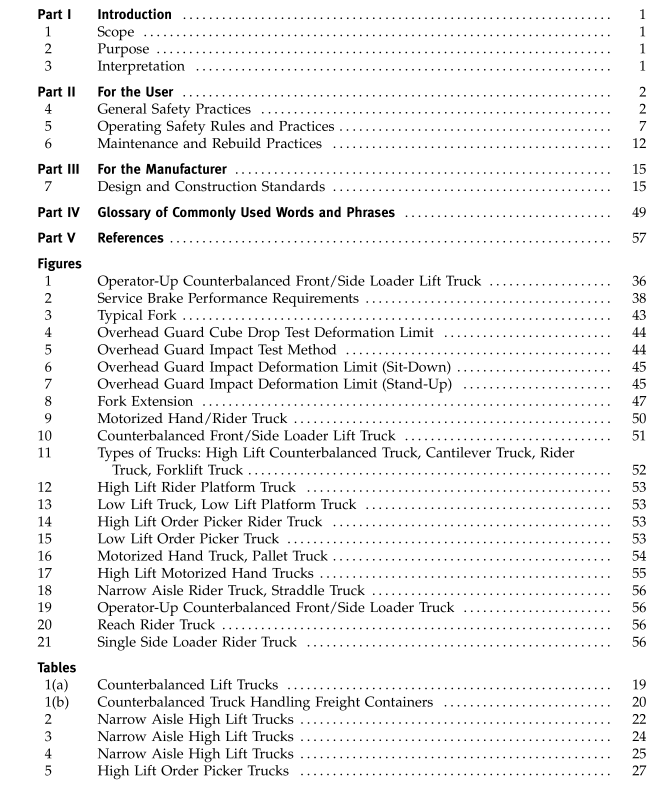ASME B56.1:2004 pdf free download Safety Standard for Low Lift and High Lift Trucks
4GENERAL SAFETY PRACTICES4.1 Introduction
4.1.1 Part ll contains requirements for the users ofpowered industrial trucks. Included are requirementsfor operator qualifications and training. operating safetyrules,and maintenance practices.
4.1.2 Unusual operating conditions may requireadditional safety precautions and special operatinginstructions.
4.1.3Supervision is an essential element in the safeoperation of powered industrial trucks.
4.2 Modifications,Nameplates,Markings, and Capacity
4.2.1 Except as provided in para.4.2.2,no modifications or alterations to a powered industrial truck thatmay affect the capacity, stability, or safe operation of thetruck shall be made without the prior written approval ofthe original truck manufacturer or its successor thereof.When the truck manufacturer or its successor approvesa modification or alteration, appropriate changes shallbe made to capacity plates, decals, tags, and operationand maintenance manuals.
4.2.2 lf the truck manufacturer is no longer in busi-ness and there is no successor to the business, the usermay arrange for a modification or alteration to a pow-ered industrial truck, provided however, the user
(a) arranges for modification or alteration to bedesigned,tested,and implemented by an engineer(s)expert in industrial trucks and their safety
(b) maintains a permanent record of the design,test(s), and implementation of the modification or alter-ation
(c) makes appropriate changes to the capacity
plate(s),decals, tags,and operation and maintenancemanuals
(d) affixes a permanent and readily visible label onthe truck stating the manner in which the truck hasbeen modified or altered together with the date of themodification or alteration, and the name of the organiza-tion that accomplished the tasks
4.2.3 If the truck is equipped with a front-end attach-ment(s), including fork extensions,the user shall seethat the truck is marked to identify the attachment(s).
show the weight of the truck and attachment combina-tion,and show the capacity of the truck with attach-ment(s) at maximum elevation with the load laterallycentered.1
4.2.4The user shall see that all nameplates and cau-tion and instruction markings are in place and legible.4.2.5The user shall consider that changes in loaddimension may affect truck capacity.
4.2.6 Fork extensions shall be designed for the appli-cation.
4.2.7 When modifications involve rebuild and repairof the basic unit, they shall be made in accordance withthe manufacturer’s established criteria and procedures(see para.6.2).
4.2.8 Where steering must be accomplished withone hand using a steering handwheel, a steering knob(s)or equivalent shall be used to promote safe and effectiveoperation. The steering handwheel and knob configura-tion shall be of a design that will minimize the hazardfrom a spinning handwheel due to a road reaction feed-back, or the steering mechanism shall be of a type thatprevents road reactions from causing the steering hand-wheel to spin. The steering knob(s) shall be within theperiphery of the steering handwheel.
4.2.9Where steering can be accomplished witheither hand, and the steering mechanism is of a typethat prevents road reactions from causing the handwheelto spin (power steering or equivalent), steering knobsmay be used. When used, steering knobs shall be of atype that can be engaged by the operator’s hand fromthe top, and shall be within the periphery of the steeringhandwheel.
4.2.10 Batteries used in electric trucks shall complywith the minimum / maximum battery weight rangeshown on the truck nameplate.
4.3 Stopping Distance (Descending Grades)
4.3.1 When descending a grade, stopping distancewill be greater than on-level operation. Methods shallbe provided to allow for this condition. Some methodlsare: reduce speed,limit loads, allow adequate clear spaceat the bottom of the grade, etc. (see para.5.3.8).
ASME B56.1:2004 pdf free download
